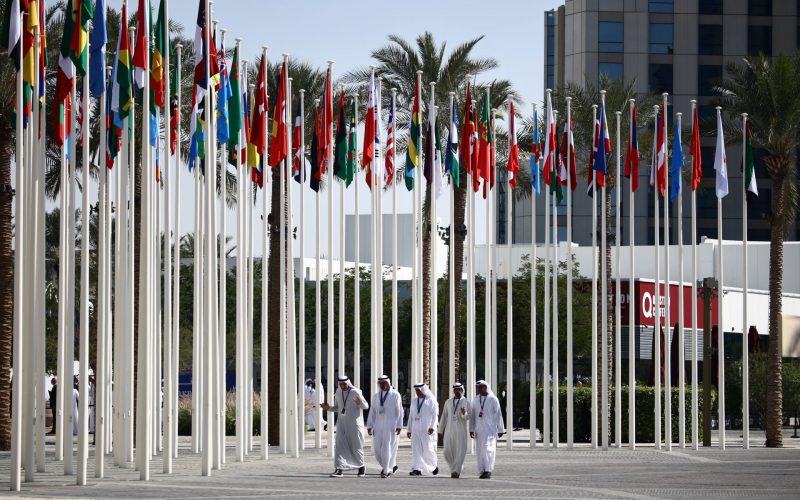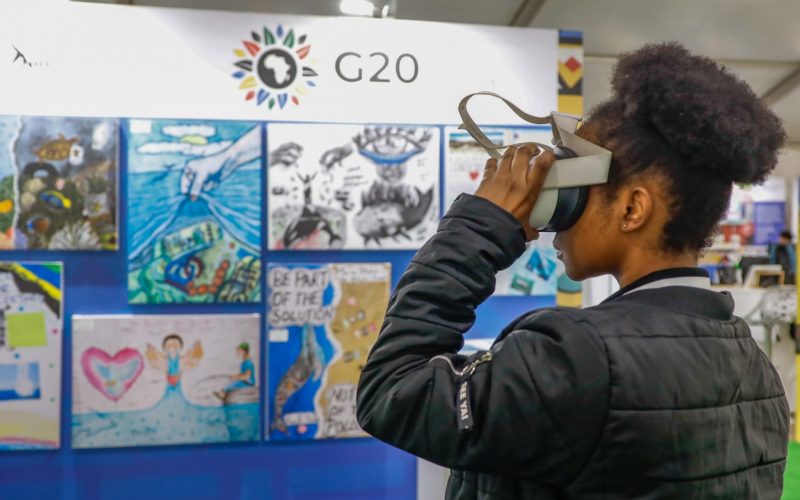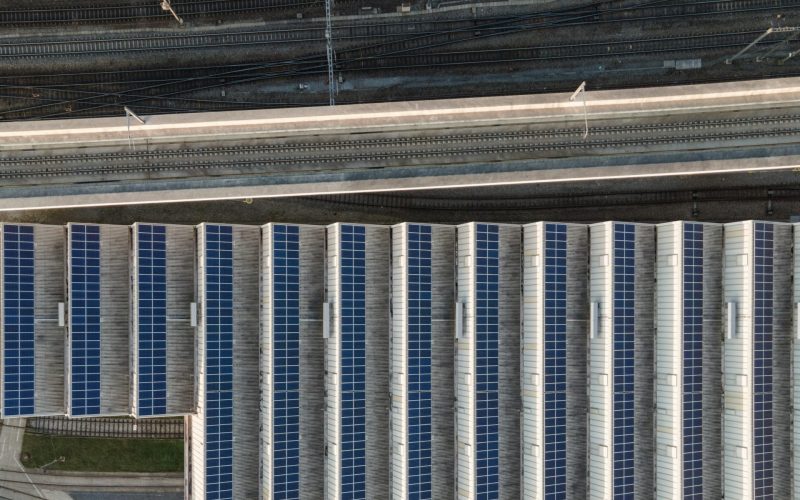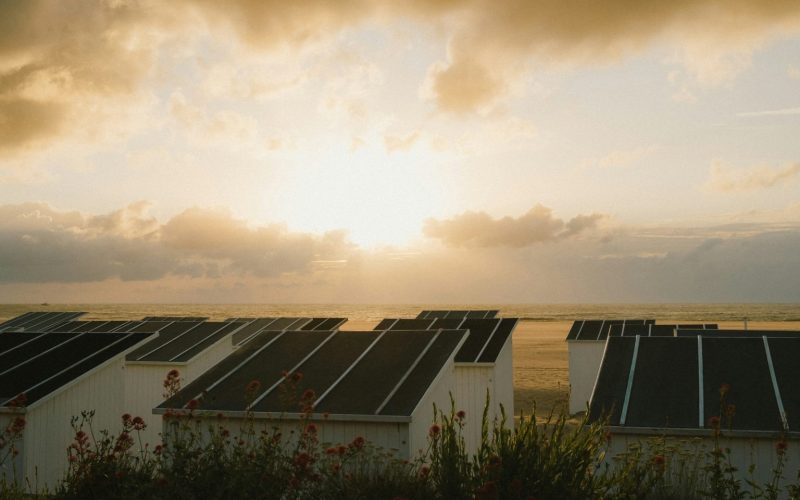Recommendations
- African stakeholders should proactively plan to ensure that climate change interventions are integrated and mutually reinforcing in the post-2020 Global Biodiversity Framework (GBF), as treating climate, biodiversity and human society as integrated systems is key to successful policy outcomes.
- African stakeholders should push for climate finance negotiations to be ‘nature-positive’ and not just climate-positive, in particular by utilising a true nature-based solutions lens.
- When planning for implementation, state and non-state actors should prioritise working with and building capacity in the local and rural communities most affected by climate impacts, biodiversity loss and (consequently) livelihood degradation.
- Africa should take a strong leadership role in the post-2020 GBF negotiations to ensure the agreement is relevant to Africa and the Global South, and to avoid mitigation maladaptations.
Executive summary
Growing evidence indicates that addressing the twin challenge of the climate crisis and the biodiversity crisis requires greater synergy and integration across these two sectors, and for them to be treated as two components of the same challenge. Africa should take a strong leadership role in the negotiations to finalise the CBD Post-2020 Global Biodiversity Framework (GBF) in 2022, to ensure greater relevance for Africa and that both the climate crisis and biodiversity crisis are addressed simultaneously. This requires that the final GBF goals are evidence-based and focused on achieving both nature-positive and climate-positive outcomes. Achieving these objectives will also result in people-positive outcomes – but only if there is far greater inclusion of communities and groups directly affected by policy interventions from the outset. In finalising the GBF this year, the use of a nature-based solutions lens should be explicitly built into the GBF goals to ensure a triple win of climate-, biodiversity- and people-positive outcomes.
Introduction
The world is currently facing a number of significant, ubiquitous challenges, two of which – the biodiversity crisis and the climate crisis – are increasingly referred to in global discourse as existential threats. While each of these crises has been recognised globally for decades and is being addressed separately under their respective multilateral environmental agreements (MEAs), namely the UN Convention on Biological Diversity (CBD) and the UN Framework Convention on Climate Change (UNFCCC), there are increasing calls from leading scientific voices across the globe 1Intergovernmental Science-Policy Platform on Biodiversity and Ecosystem Services (IPBES), IPBES-IPCC Co-sponsored workshop report on biodiversity and climate change, (2021); UNEP-WCMC, Tackling climate change and biodiversity loss together, (Cambridge UK: UNEP-WCMC, 2020). for solutions to be integrated across these two MEAs, as they are interlinked environmental crises that can only be addressed together.2While legitimate calls are also being made for wider integration with other MEAs, for purposes of this policy brief, we focus on these two most closely aligned MEAs only
Natural resource degradation through human impacts such as land-use changes that undermine natural carbon stocks and sequestration, is a major contributor to cumulative CO2 emissions and, therefore, an important additional driver of climate change. Naturebased solutions (NbS) can play a key role in helping societies adapt to climate impacts. When climate and biodiversity actions are not integrated, supposed solutions can easily result in maladaptations, with climate solutions undermining biodiversity goals and resulting in nature-negative outcomes, and thus climate-negative outcomes. For African countries (and the Global South in general), a key issue should be ensuring that pledged climate funding and implementation actions do not result in such maladaptations, thereby undermining the goals of the Post-2020 Global Biodiversity Framework (GBF) and exacerbating human vulnerability across the continent. Strong African leadership must seek to ensure that key African priorities are built into the GBF.3Nicholas King, “Key African Priorities for a Post-2020 Global Biodiversity Framework” (Policy Brief 196, South African Institute of International Affairs, Johannesburg, 2020), https://saiia.org.za/research/key-african-priorities-for-a-post-2020-global-biodiversityframework/.
State of the biodiversity and climate conventions
The Convention on Biological Diversity and the UNFCCC were two of the three 4The third Rio Convention is on combatting desertification, and of lesser scope, see https://www.unccd.int/. MEAs to emerge from the 1992 Rio Earth Summit, and are now 30 years old. It is unfortunate that these two conventions were not more closely aligned at the time. Nevertheless, the overlap, synergy and potential conflict between addressing biodiversity loss and climate change have been increasingly recognised, and these interlinkages have been made explicit in a number of decisions made under these conventions to date.5Including, for example: UN Convention on Biological Diversity Decision X/33; Decision XIII/4; Decision 14/5. The current focus of negotiations under the CBD is finalising the GBF. This is the key next milestone towards the CBD’s 2050 vision of ’living in harmony with nature‘, and will outline a strategic roadmap for the ’conservation, protection, restoration and sustainable management of biodiversity and ecosystems‘ for the next decade. It follows closely on the CBD’s previous decade-long strategic framework to shift global development onto a path to attain the 2050 vision referred to as the 2020 Aichi Biodiversity Targets. The first draft of the GBF was developed over the previous two years, and the intention was for it to be finalised at CBD COP15. This meeting was to be held in Kunming, China in late 2020, but it was delayed due to the COVID-19 pandemic and then split into two sessions. The first, COP15/1 was held virtually in October 2021. It resulted in the Kunming Declaration, which re-affirmed countries’ commitments to an effective policy framework – in the form of the GBF – for ‘bending the curve on biodiversity loss by 2030’. The second, CBD COP15/2, is scheduled to be held in Kunming, in May 2022. The final GBF draft will then be presented for adoption. It is imperative that the Global South, and Africa in particular, takes a strong leadership position, in order to influence the final GBF to meet their requirements. These priorities are outlined below.
In terms of global climate negotiations, the most significant outcomes of the UNFCCC to date are those of the 2015 Paris Agreement on rapidly reducing emissions, strengthening adaptation, and developing common mechanisms for measuring implementation, reporting and verification (Paris Rulebook). Most importantly, Articles 7 and 8 of the Paris Agreement make reference to the protection and restoration of ecosystems and natural resources as part of the global climate response.
The UNFCCC’s 26th COP (COP26) was postponed for a year because of COVID-19, but was finally held in Glasgow, UK, in November 2021. It resulted in the Glasgow Climate Pact. One of the most important outcomes of COP26 is that all of the incomplete aspects of the Paris Rulebook were finalised, which means that the Paris Agreement is now fully operational.
In pushing for commitment to ‘net-zero by 2050’, the Glasgow Climate Pact agreed to various measures to reduce unabated use of coal power, halt and reverse deforestation and land degradation, reduce methane emissions and speed up the transition to electric transport. All major coal-financing countries committed to ending international coal finance by the end of 2021, and over $20 billion was committed to supporting developing countries to scale up clean power and transition from using coal.
Developed countries renewed their pledge to deliver the annual $100 billion climate finance goal by 2023 at the latest, and agreed a roadmap for a new post-2025 climate finance goal that would exceed this figure. The 266The number of finance institutions at the time of COP26. leading bilateral and regional development finance institutions comprising the International Development Finance Club committed to a new finance target of $1.3 trillion for the period 2019 to 2025.
Whether these pledges will be fulfilled partially or fully, only time will tell. However, what is important is not so much the amount of finance, but its application. Policy planning in the Global South needs to proactively ensure that all possible regulatory and capacity requirements are in place to take advantage of the climate finance that will be provided, and ensure it is utilised and implemented in a nature-positive way, as the GBF is quite specific on how the climate finance should be aligned with the GBF goals. This is the challenge for African negotiators in the lead-up to, and final negotiations to be engaged in at the second session of CBD COP15. Further, Africa needs to take a far greater leadership role at UNFCCC COP27, to be held in Egypt in late 2022. Consistently strong leadership at UNFCCC this year, on the integrated African priorities from the CBD, is critical to ensuring successful outcomes for Africa at these negotiations.
The rationale for integrated policy and action
While various components of the goals set by the UNFCCC and the CBD do link to each other, this linking is not mandated in either as yet. Climate change and biodiversity loss are closely interconnected and share a common driver – human activity. Conserving, restoring and managing ecosystems for integrated outcomes are thus key to the success of both these conventions. With growing scientific recognition of this critical issue, the two intergovernmental bodies that assess available knowledge (the Intergovernmental Platform on Biodiversity and Ecosystem Services (IPBES) and the Intergovernmental Panel on Climate Change (IPCC)), recently held the first collaborative scientific workshop, and stated:7IPBES, IPBES-IPCC Co-Sponsored, 5.
Only by considering climate and biodiversity as parts of the same complex problem, which also includes the actions and motivations and aspirations of people, can solutions be developed that avoid maladaptation and maximise the beneficial outcomes. Seeking such solutions is important if society wants to protect development gains and expedite the move towards a more sustainable, healthy and equitable world for all.
The scientific findings of the joint workshop make it clear that ambitious implementation of land- and ocean-based action to protect, sustainably manage and restore ecosystems have important co-benefits for climate mitigation, climate adaptation and biodiversity objectives and can assist in containing temperature rise within the limits indicated by the Paris Agreement. The report makes it clear that the opposite is also true, ie, a nonintegrated approach risks significant maladaptation. For example, the Glasgow Climate Pact committed to reducing deforestation; however, the IPBES-IPCC report cites voluminous evidence that policies that promote afforestation (planting trees in landscapes that were not forests historically) and reforestation with monocultures (especially with non-indigenous species, such as when planting vast areas under monoculture bioenergy crops), is highly detrimental to biodiversity, impedes progress being made with biodiversity goals and is questionable in terms of mitigation and adaptation benefits. The findings also show that afforestation degrades many other natural resource benefits to local people, and often displaces them or curtails their access to and use of the land. Further, technology-based options for climate change mitigation can pose a serious threat to biodiversity and cause displacement of people, for example, with the development of large solar farms, windfarms and hydro-electric schemes. Similarly, with adaptation, the report cites, for example, that increasing irrigation capacity is a common adaptive response used in agriculture, which can lead to conflict over water-use and lowering of water-tables.
The question must be asked: What then, is the most effective approach to integrated solutions?
Nature-based solutions for nature-, people-, and climate-positive outcomes
Action to protect, sustainably manage and restore natural and modified ecosystems, which address climate mitigation and adaptation, are most often referred to as NbS. While a number of NbS definitions exist, the scientific community has largely coalesced around that developed by the IUCN through wide consultation:8International Union for Conservation of Nature, Nature-based Solutions for People and Planet. (Gland: IUCN, 2016); It is important to note that the NbS concept is broader than, and encompasses, the definition of ecosystem-based adaptation: ‘the use of ecosystem management activities to increase the resilience and reduce the vulnerability of people and ecosystems to climate change’. NbS is thus an umbrella term incorporating ecosystem-based approaches, and this needs much greater emphasis in the GBF. The Kunming Declaration notes that ‘Ecosystem-based approaches may also be referred to as NbS as per SBSTTA recommendation 23/2, paragraph 4’.
Nature-based solutions are actions to protect, sustainably manage, and restore natural and modified ecosystems that address societal challenges effectively and adaptively, simultaneously providing human well-being and biodiversity benefits.
In addition to defining NbS, the IUCN developed a global standard that defines what NbS is not, to prevent unanticipated negative outcomes or misuse. This standard enables state and non-state actors, funding agencies and other stakeholders to assess the appropriateness and effectiveness of NbS options prior to implementation. The concept of NbS in climate change has gained considerable scientific traction. For example, a recent survey of over 500 sustainability professionals showed that the most desired outcome of COP26 was an agreement on integrating NbS into the Paris Agreement. Unfortunately, the same cannot be said of political traction, and NbS policy statements are yet to be fully translated into policy implementation on the ground at scale, despite the growing body of evidence that attests to their effectiveness, and to NbS being one of the most cost-effective approaches to both mitigating and adapting to climate change.9A recent global analysis of decades of work done before the concept became widely accepted has shown that NbS are often as effective or more effective than alternative interventions for addressing climate impacts, but at a lower cost. See Alexandre Chausson et al., ‘Mapping the effectiveness of nature-based solutions for climate change adaptation,’ Global Change Biology 26, (2020). https://onlinelibrary.wiley.com/doi/10.1111/gcb.15310. This means that an NbS lens provides an incredible opportunity for African leadership in finalising the GBF in a way most beneficial to Africa.
NbS matters such as restoration are particularly effective because, unlike infrastructurebased interventions, interventions that improve biodiversity usually also contribute to both mitigation and adaptation. In addition to carbon sequestration, restoring natural resources can help communities adapt to the negative impacts of climate change. Recent wideranging research done by UNEP-WCMC and others found that restoring 30% of converted farmland in priority areas through improved agriculture would prevent over 70% of projected extinctions of vertebrate species, while enabling sequestration of about half of all CO2 emissions to date.10UNEP-WCMC, Ecosystem restoration could prevent over 70% of extinctions, (Cambridge UK: UNEP-WCMC, 2020).
From a multi-MEA solving perspective, possibly the most important ecosystem for Africa is forests, including dryland forests, which are most vulnerable to rising temperatures.11Nicholas King, “Southern Africa’s Dryland Forests and Climate Change Adaptation” (Policy Brief 91, South African Institute of International Affairs, Johannesburg, 2014), https://saiia.org.za/research/southern-africas-dryland-forests-and-climate-changeadaptation/ Forests are arguably the most biodiverse and threatened ecosystems on the continent, while they are estimated to absorb about 30% of current carbon emissions.12UNEP-WCMC, Tackling climate change Conservation and restoration of upland forests also assists with adaptation to increasingly extreme rainfall events by stabilising mountain slopes, preventing the devastating mudslides that now regularly follow forest fires, and enhancing water security and flood protection for downstream users.
At a recent regional training workshop for African forestry stakeholders on forest and treebased climate change mitigation, Executive Secretary of the African Forest Forum (AFF), Godwin Kowero, emphasised the dire need for climate change adaptation support across the agricultural sector. This would prevent further forest destruction, as climate change impacts reduce productivity and force people to convert more land. The AFF’s Climate Change Programme seeks to integrate solutions for ‘African forests, people and climate change’. This inclusivity principle is paramount to successful implementation of NbS and the nature-, people-, climate-positive outcomes sought.
Participatory inclusion of all stakeholders
Over-simplified messages regarding large-scale purported NbS may risk having an adverse effect on biodiversity and livelihoods, especially if the local context is not considered. In order to achieve successful outcomes, it is imperative that approaches include co-designing projects with local stakeholders and basing interventions on a solid understanding of the local context, rights and needs. While the Glasgow Climate Pact emphasises the importance of human rights and collaboration across all sectors of society, encouraging local, regional, national and cross-sectoral partnerships to deliver effective climate action and a just transition, real involvement of marginalised groups is required to improve the outcomes of climate finance implementation.13Siri Eriksen et al., Adaptation Interventions and their Effect on Vulnerability in Developing Countries: Help, Hindrance or Irrelevance? World Development 141, (2021), doi:10.1016/j.worlddev.2020.105383.
Such inclusivity is not confined to rural contexts. For the first time in human history, more than half of humanity lives in cities. As urban areas continue to expand, so the need for greater investment in ecological infrastructures grows, in order to combat both the impacts of climate change and the biodiversity loss brought about by land-use change in built environments.14World Economic Forum & Alexander von Humboldt Institute, BiodiverCities by 2030: Transforming Cities’ Relationship with Nature. Insight Report (Geneva: WEF, 2022). Awareness is growing rapidly of the need to reduce the negative impacts that cities have on nature, and to implement NbS to enhance urban environments as places to live and thrive for both humans and other species.
The first draft of the GBF already emphasises the need for a whole-of-society approach that is intended to expand the implementation actions beyond just state actors and to include non-state actors. By using an NbS lens, the GBF will enable a much wider cross-section of stakeholders to contribute to improved outcomes of both the biodiversity and climate MEAs, and assist governments to deliver on their wider socio-economic commitments to achieving the SDGs.
Conclusion
Successfully addressing the twin environmental crises of the early 21st century – biodiversity loss and climate change – calls for a more integrated, mutually reinforcing policy approach than has been envisaged to date in the Post-2020 GBF. One such approach that is gaining considerable traction, and which is based on scientific evidence, is NbS. Viewing the two crises as two components of the same challenge enables a more coherent approach. For Africa, with its particular vulnerability to climate change impacts, but a relatively intact natural resources base, the solution to climate and biodiversity challenges through NbS offers easily the most consistent, comprehensive and cost-effective framework for addressing these inter-linked challenges.
Of critical importance is that these solutions must be approached, planned and implemented with the full knowledge, participation and ownership of local communities. Using an NbS lens as the basis for the GBF will improve the integration of a range of solutions, and address both the climate crisis and biodiversity crisis simultaneously. Conversely, ignoring the inseparable nature of climate, biodiversity and human quality of life will result in sub-optimal solutions to both crises, which will impact people negatively. Treating climate, biodiversity and human society as integrated systems is key to successful policy interventions.
Acknowledgement
SAIIA gratefully acknowledges the support of SIDA for this publication.








